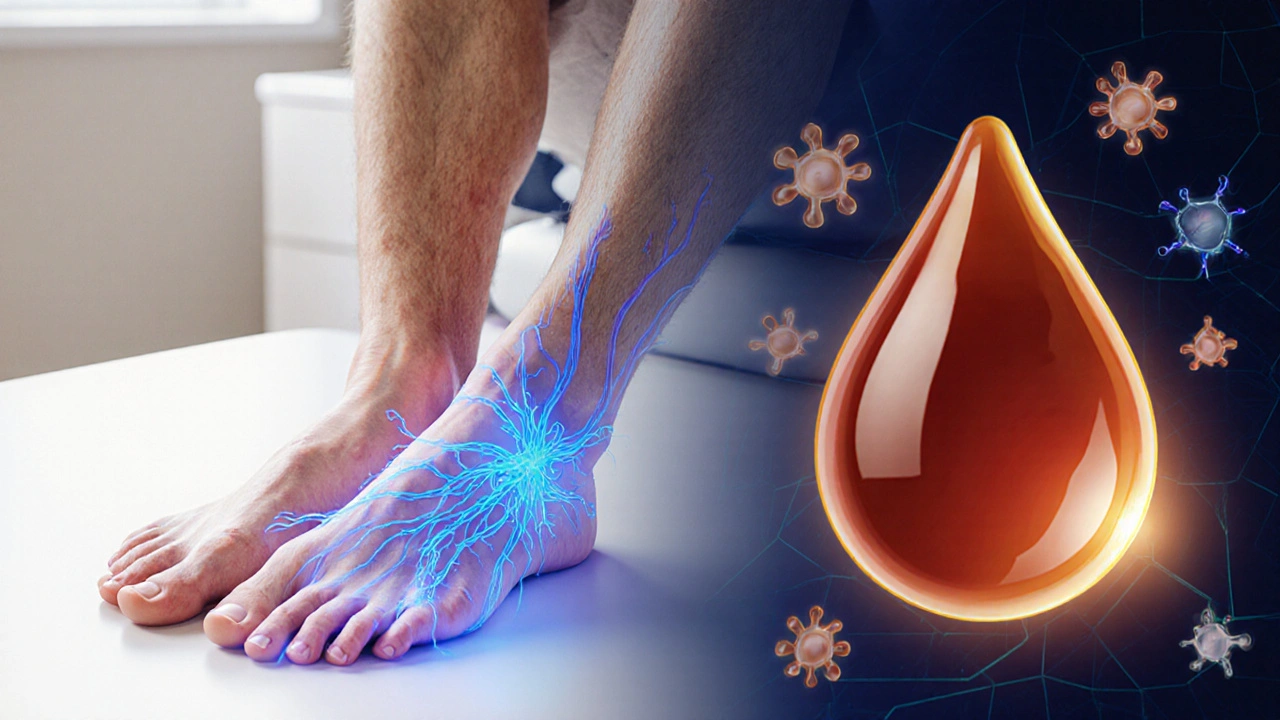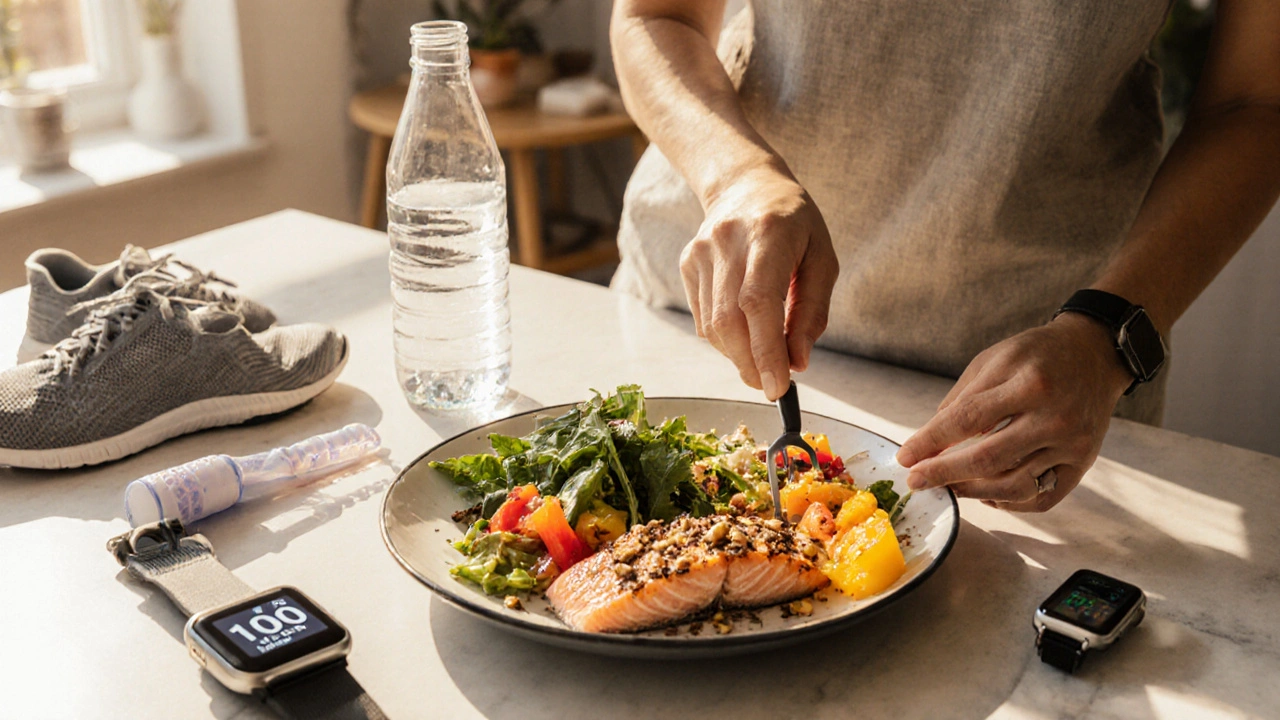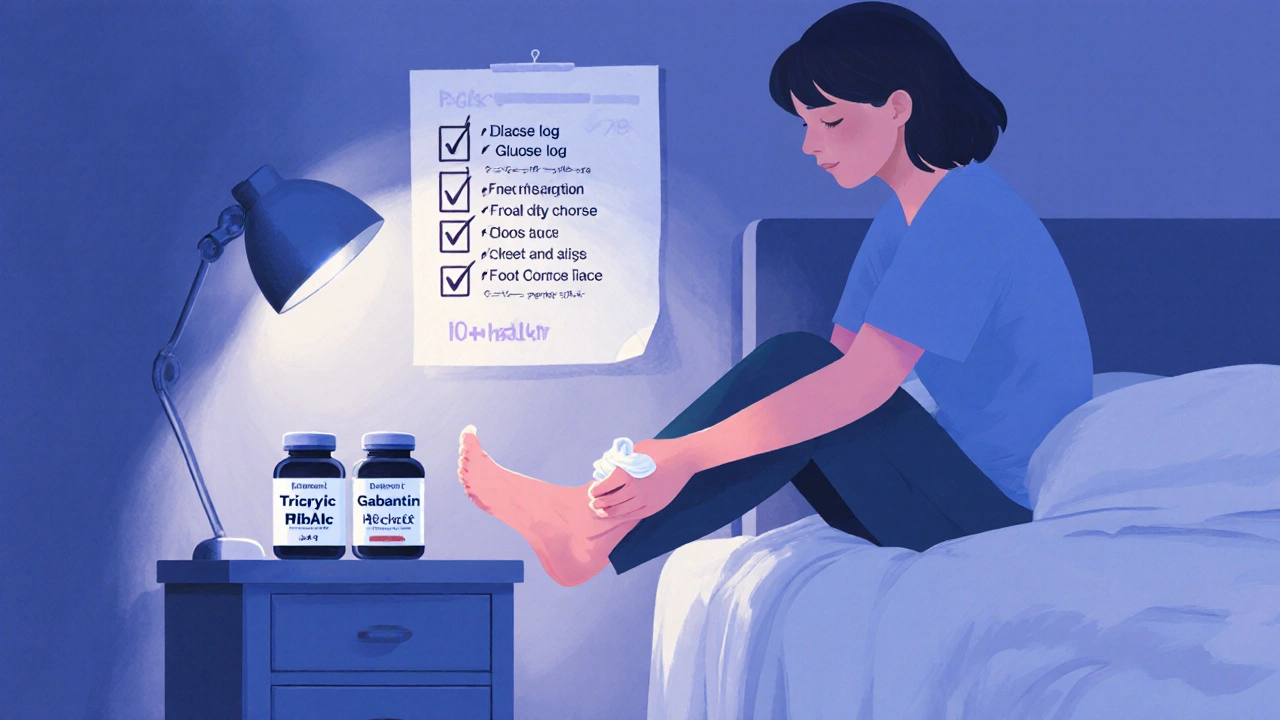 Oct, 8 2025
Oct, 8 2025
Diabetic Peripheral Neuropathy Risk Calculator
Enter Your Information
Your Risk Assessment
Risk Factors Table
| HbA1c Range | Risk Reduction | Notes |
|---|---|---|
| ≤6.5% | ≈15% lower | Ideal for younger, active patients |
| 6.6 – 7.0% | ≈30% lower | Standard clinical target |
| 7.1 – 8.0% | ≈10% lower | Acceptable for older adults or those with hypoglycaemia risk |
| >8.0% | No significant reduction | Urgent treatment escalation needed |
Living with diabetes means juggling many health priorities, and one that often slips under the radar is Diabetic Peripheral Neuropathy is a chronic nerve‑damage condition that typically starts in the feet and hands. If you’ve ever wondered whether keeping your blood sugar control tight actually makes a difference, the short answer is a resounding yes - and the long answer involves hormones, blood vessels, and everyday habits.
Key Takeaways
- Consistently low Hemoglobin A1c (≤7%) reduces the risk of nerve damage progression by up to 40%.
- Combining medication adherence with diet, exercise, and regular foot checks yields the best outcomes.
- Early detection through nerve‑conduction tests and symptom questionnaires allows timely intervention.
- Managing pain with both glucose‑focused and neuropathic‑pain‑specific therapies improves quality of life.
- A simple weekly checklist keeps you on track and helps your care team spot problems early.
What Is Diabetic Peripheral Neuropathy?
In plain terms, Diabetic Peripheral Neuropathy (DPN) is the gradual loss of nerve function caused by prolonged high blood glucose. The nerves most often affected are those that run down the legs and arms, leading to tingling, numbness, burning, or sharp pain. Over time, the lack of sensation can hide injuries, making foot ulcers and infections a common and serious complication.
Data from the International Diabetes Federation (2023) show that roughly 30% of adults with type 2 diabetes develop DPN, and the risk climbs sharply after ten years of uncontrolled glucose levels.
Why Blood Sugar Control Matters for Nerve Health
High glucose environments trigger several harmful processes:
- Advanced Glycation End‑Products (AGEs): Excess sugar binds to proteins, forming AGEs that stiffen blood‑vessel walls and impair blood flow to nerves.
- Oxidative Stress: Free radicals damage nerve cell membranes, slowing signal transmission.
- Inflammatory Cytokines: Chronic inflammation skews the repair mechanisms that nerves rely on.
When blood sugar control brings glucose levels back into a normal range, these pathways quiet down, allowing damaged nerves a chance to heal or at least stop worsening.

Setting Practical Glycemic Targets
The most widely accepted benchmark is Hemoglobin A1c, a blood test that reflects average glucose over the past three months. For most adults without severe comorbidities, the target is ≤7.0%. Below are typical ranges and their associated risk reductions for DPN:
| HbA1c (%) | Annual Risk of DPN Progression | Notes |
|---|---|---|
| ≤6.5 | ≈15% lower | Ideal for younger, active patients |
| 6.6-7.0 | ≈30% lower | Standard clinical target |
| 7.1-8.0 | ≈10% lower | Acceptable for older adults or those with hypoglycaemia risk |
| >8.0 | No significant reduction | Urgent treatment escalation needed |
These numbers come from a 2022 cohort study that followed 5,000 patients with type 2 diabetes for five years, tracking neuropathy progression with nerve‑conduction studies.
Everyday Strategies to Keep Glucose in Check
Achieving the targets above isn’t about a single miracle pill; it’s a blend of medication, diet, activity, and monitoring.
- Medication Adherence: Most people rely on Metformin as a first‑line agent. If HbA1c stays above goal, adding a GLP‑1 receptor agonist (e.g., liraglutide) or an SGLT2 inhibitor (e.g., empagliflozin) can improve control while offering cardiovascular benefits.
- Carbohydrate‑Smart Eating: Aim for a plate half‑filled with non‑starchy vegetables, a quarter with lean protein, and a quarter with whole‑grain carbs. The Mediterranean‑style pattern has shown a 0.5% HbA1c reduction on average.
- Consistent Physical Activity: 150 minutes of moderate aerobic exercise weekly-think brisk walking, cycling, or swimming-enhances insulin sensitivity. Resistance training twice a week further supports glucose uptake by muscles.
- Regular Glucose Monitoring: For those on insulin or sulfonylureas, checking fasting and post‑meal readings at least twice daily uncovers patterns and prevents spikes that damage nerves.
- Stress Management: Cortisol spikes raise blood sugar. Simple techniques like 5‑minute breathing, mindfulness apps, or short walks can keep stress‑induced hyperglycaemia at bay.
Pair these habits with routine foot care-daily inspection, moisturising (avoid between toes), and proper footwear-to cut down the chance of ulcers.
How to Track Progress and Spot Trouble Early
Beyond HbA1c, clinicians use a few other tools to gauge neuropathy status:
- Monofilament Test: A 10‑gram filament checks sensation on the big toe; inability to feel it flags high ulcer risk.
- Vibration Perception Test with a tuning fork (128 Hz) assesses large‑fiber function.
- Nerve Conduction Studies (NCS): These electrophysiological tests quantify speed and amplitude of nerve signals, offering objective measurement of progression.
Schedule these assessments at least annually, or sooner if you notice new tingling, burning, or loss of balance.

Managing Neuropathic Pain While Keeping Glucose in Check
Even with perfect glucose control, some patients still experience pain. Here’s a balanced approach:
- First‑Line Analgesics: Low‑dose tricyclic antidepressants (e.g., amitriptyline) or SNRIs (e.g., duloxetine) are effective and have the added benefit of modestly improving glycaemic parameters.
- Second‑Line Options: Gabapentin or pregabalin target calcium channels on overactive nerves. Start low, increase gradually to avoid sedation.
- Topical Therapies: Capsaicin 8% patches or lidocaine 5% creams provide localized relief without systemic side effects.
- Complementary Measures: Regular foot massage, warm (not hot) foot baths, and graduated compression stockings improve circulation.
Always discuss new pain meds with your diabetes team, as some can influence blood sugar (e.g., certain antidepressants may raise glucose).
Weekly Checklist for Self‑Management
- ☐ Record fasting and post‑meal glucose readings.
- ☐ Review medication doses; note any missed pills.
- ☐ Follow the Mediterranean‑style meal plan for at least five days.
- ☐ Complete 30minutes of moderate activity, split as you like.
- ☐ Inspect both feet-look for redness, cracks, or swelling.
- ☐ Perform the monofilament test at home (optional) and document sensation.
- ☐ Log any new tingling, pain, or balance issues and inform your clinician.
Cross‑checking this list each week helps you catch early warning signs before they turn into emergencies.
Frequently Asked Questions
Can I reverse diabetic peripheral neuropathy by improving my blood sugar?
You can’t fully reverse nerve damage that’s already severe, but tight blood sugar control can halt further loss and even improve mild symptoms in many people. Early intervention is the key.
How often should I get my HbA1c tested?
If your levels are stable and within target, every three months is sufficient. When you’re adjusting medications or experiencing spikes, testing every six weeks may be advisable.
What foods are best for protecting my nerves?
Focus on low‑glycaemic carbs (whole grains, legumes), omega‑3‑rich fish, leafy greens, nuts, and antioxidant‑heavy berries. These choices lower inflammation and support vascular health.
Is exercise safe if I already have neuropathy?
Yes, but choose low‑impact activities like walking, swimming, or stationary cycling. Avoid high‑impact sports that could cause foot injuries before sensation returns.
Do pain medications affect my blood sugar?
Some, like certain tricyclic antidepressants, may slightly raise glucose. Always discuss dosage and alternatives with your diabetes care team.
When should I see a podiatrist?
If you notice any cuts, blisters, persistent redness, or loss of sensation, book an appointment within a week. Routine annual visits are recommended even if you feel fine.
Bottom line: keeping glucose levels steady isn’t just about avoiding sugar spikes-it’s a proven way to keep the nerves in your feet and hands from deteriorating further. Pair tight control with proactive foot care, pain‑management strategies, and regular check‑ups, and you’ll give yourself the best chance at living pain‑free for years to come.
Ian Howard
October 8, 2025 AT 14:47Wow, the way blood‑sugar control weaves into nerve health is like watching a master painter blend hues on a canvas – each shade matters. Keeping that HbA1c under 7% isn’t just a number; it’s a protective shield that slows the march of neuropathy. Think of your pancreas as a diligent gardener, pruning excess glucose before it can choke the delicate vasculature feeding your nerves. The dreaded AGEs and oxidative stress? They’re the invasive weeds that thrive when you let sugar run wild. So, tighten those reins on your diet, stay on top of your meds, and give those peripheral nerves a fighting chance to stay vibrant.
Chelsea Wilmer
October 9, 2025 AT 22:15One cannot simply glance at a table of HbA1c percentages and assume the story ends there; the narrative of diabetic peripheral neuropathy is a profound tapestry woven from biochemical, physiological, and existential threads. When glucose persistently hovers above the optimal threshold, the body embarks on a relentless production of advanced glycation end‑products, which act like corrosive anchors anchoring the walls of tiny blood vessels, thereby starving the nerves of essential oxygen and nutrients. Moreover, the cascade of oxidative stress does not merely flirt with neuronal membranes – it aggressively invades, compromising ion channels and disrupting the elegant choreography of signal transmission. In the quiet corners of our laboratory of life, inflammatory cytokines multiply like restless philosophers, debating the fate of reparative mechanisms while offering no solace to the suffering individual. It is within this turbulent micro‑environment that the myth of ‘reversal’ begins to crumble; while you may halt progression, the notion of fully restoring severely damaged fibers remains, alas, an aspirational ideal. Yet, hope is not lost, for early detection via monofilament testing and nerve conduction studies provides a lantern in this dim corridor, illuminating the path to timely intervention. The convergence of disciplined medication adherence, Mediterranean‑style nutrition, and consistent aerobic activity forms a triad of guardians that collectively mitigate the onslaught of peripheral nerve degeneration. As we contemplate the future, emerging therapies targeting the AGE pathway promise to add another brushstroke to this complex masterpiece, perhaps one day allowing us to repaint the canvas with broader strokes of recovery. In sum, the interplay between meticulous glucose regulation and neuropathy management is not a mere clinical footnote but a profound testament to the body's resilience when guided by informed, proactive stewardship.
David Stout
October 11, 2025 AT 05:44Friends, think of your health journey as a marathon, not a sprint. Every day you log your sugars, take your meds, and move a bit, you’re laying bricks on a sturdy road to freedom from pain. If you stumble, remember it’s just a pebble-not a wall. Keep that momentum, support your peers, and watch the neuropathy risk shrink like ice in the sun.
Pooja Arya
October 12, 2025 AT 13:13While enthusiasm propels many forward, let us not ignore the moral imperative to confront the silent epidemic of neglect. The data presented is not a mere academic exercise; it is a call to conscience for societies that allow chronic disease to fester unchecked. We must demand equitable access to glucose monitoring tools, lest the vulnerable be left to wander in darkness. To turn a blind eye is to betray the very ethical foundations upon which compassionate medicine stands. Let us, therefore, elevate the discourse beyond statistics and champion justice for every foot and hand awaiting relief.
Sam Franza
October 13, 2025 AT 20:41Stick to your plan and track daily.
Raja Asif
October 15, 2025 AT 04:10Enough of this soft‑sell nonsense! The real issue is that our health policies are too weak, and we need a national push to enforce stricter glucose standards. If we don't act now, our seniors will continue to suffer needless neuropathy, and that's unacceptable.
Matthew Tedder
October 16, 2025 AT 11:39It’s understandable to feel frustrated, but let’s channel that energy into constructive steps: share reliable resources, encourage regular check‑ups, and support each other in maintaining those HbA1c goals. Together we can make a difference.
Cynthia Sanford
October 17, 2025 AT 19:07Great tips, feeling hopeful!
Yassin Hammachi
October 19, 2025 AT 02:36Optimism is a powerful ally in the fight against chronic illness. When we view each glucose reading as a reflection of our commitment rather than a judgment, the path forward becomes clearer. Let us embrace both the science and the spirit of perseverance.
Michael Wall
October 20, 2025 AT 10:05While positivity is nice, it must be grounded in reality. Ignoring the harsh facts about systemic failures does no one any favors; acknowledging them is the first step toward genuine improvement.